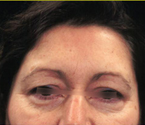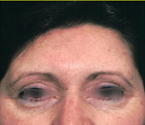Upper Eyelid Surgery In Chicago, IL
Home / Face & Neck Procedures In Chicago, IL / Upper Eyelid Surgery In Chicago, IL
* Individual results may vary.
Photo Gallery
View before-and-after pictures of real patients of Dr. Laurie A. Casas
View Before & Afters
Upper-eyelid surgery, also known as upper-blepharoplasty, is a facial procedure that can rejuvenate the appearance of saggy, wrinkled, and droopy upper-eyelids. Upper eyelids can begin to wrinkle and sag as a result of aging and other factors. At Casas Aesthetic Plastic Surgery, we have provided numerous men and women with natural-looking results from their upper-eyelid surgery in Chicago. Board-certified plastic surgeon Dr. Laurie Casas has been expertly trained in the field of facial plastic surgery and can provide you with the personalized care you need.
Good Candidates for Upper-Eyelid Surgery
A candidate for eyelid surgery may have excess skin of the upper or lower eyelids leading to wrinkling, puffiness, bags, or impaired vision.
During the initial consultation you will discuss with Dr. Casas what you would like to improve so that she can understand your expectations and determine whether they can realistically be achieved. Dr. Casas will then recommend the procedure to best achieve your desired result.
How Upper-Eyelid Surgery is Performed
The incisions for the procedure are made along the natural creases of the upper eyelid. This ensures that once the incisions have fully healed any post-surgical marks are hidden so that the results look as natural as possible. Excess skin and small pockets of fat are removed, and any loose muscles are trimmed and tightened. The incisions are then sutured shut.
Recovering from Your Upper-Eyelid Surgery
After surgery, you should rest quietly with your head elevated to minimize elevations in blood pressure. Dr. Casas will teach you how to best apply cold compresses to your eyes, which need to be changed every thirty minutes for the first twenty-four hours. The initial swelling will subside within one to several weeks, and bruising typically disappears within one to one-and-a-half weeks. Stitches are usually removed within a week of surgery, but contact lenses typically should not be worn for two weeks after surgery. The majority of patients will be able to resume most of their normal non-aerobic activities within one week. Dr. Casas hides the surgical incisions within natural folds of the eyelids or even on the inside of the eyelid, virtually eliminating visible long-term scars.
Manual Lymphatic Drainage, administered by massage, is used after each procedure to reduce swelling. The number of sessions is individualized. It is important that patients follow a healthy lifestyle leading up to and following procedures, including non-smoking, a healthy diet and daily vitamins. Click here to learn more.
The Cost of Upper Eyelid Surgery
The cost of your upper-eyelid surgery can vary based on several factors. During your consultation, Dr. Casas will ask about your goals for the procedure and carefully examine your upper eyelids to determine the best course of action for your procedure. She can let you know what the expected cost of your upper-eyelid surgery will be.
Schedule a Consultation Today
Contact Casas Aesthetic Plastic Surgery today to schedule a consultation for your upper-eyelid surgery in Chicago. Our team can help to rejuvenate the appearance of your upper-eyelids and restore the youthful beauty of your eyes and face.
Upper Eyelid Surgery FAQ
Knowing how long your upper blepharoplasty recovery will take can be difficult to determine. A complete recovery takes approximately three months on average; however, you will be able to enjoy your normal routine again in just two weeks.
After seven days, you should give us a call at
847-657-6884 to schedule your checkup to remove your sutures and assess the healing. If you are healing well, your surgeon will have you return at least weekly for follow-ups.
As you recover, rest your eyes and body as much as possible. This will help you recover faster. While the incisions and swelling will still be present, you can comfortably return to work in as little as 10 days.
One common question many people ask about upper blepharoplasty is if you have to be a certain age to be eligible for the procedure. If you are considering an upper blepharoplasty in Chicago, your surgeon will likely group you into one of two categories:
- Category 1 — Category 1 patients are experiencing the effects of the aging process on their eyes. Their eyelids used to open easily but have now begun to occlude their vision.
- Category 2 — Patients in this category are those with hereditary conditions affecting the eyelids. The excess skin is present during pregnancy, or the condition creates excess skin during infancy.
The surgeon may also have requirements that must be met before an upper eyelid blepharoplasty is scheduled. One requirement is good health and being a nonsmoker so that healing is not hindered.
If the patient is younger and in medical need of an upper blepharoplasty, the surgeon will deem them a good candidate based on the skin’s natural inability to improve.
Having an upper blepharoplasty at a younger age can be advantageous due to the often higher levels of health the patient has, which will allow a faster recovery.
When you undergo an upper blepharoplasty, or hooded eye surgery, there are a few ways your surgeon can ensure the pain you experience is minimal. The pain during the procedure will be controlled through anesthesia. It may be a local or general anesthetic and will be determined by the procedure(s) being conducted and if any additional procedures are done.
As you recover, you may experience pain and discomfort following surgery that may last for 36 hours. At this time, pain relievers such as Tylenol can be taken to help control your pain. Stitch removal should not cause any pain, and just a bit of tugging may be felt.
You will find relief not only with the pain relievers, but also from utilizing hot and cold compresses. These compresses will help alleviate discomfort and swelling and keep you comfortable.
Your upper blepharoplasty recovery can be a lot faster when you allow yourself enough time for it and follow all of your surgeon’s instructions.
Before your surgery, you should request some time off from work and ensure you are prepared by having your meals pre-made, prescriptions obtained, and plenty of food. You can also take the following measures to help you recover successfully:
- Avoid stressing your eyes by reading, watching TV, or using a computer.
- Elevate your head as much as possible while sleeping to reduce the buildup of fluid and decrease swelling.
- Wear sunglasses for at least two weeks to protect your eyes from the wind, sun, and dirt.
- Ensure you rest as much as possible throughout the day to alleviate feeling tired.
- Avoid activity that is strenuous for a few weeks until your surgeon medically clears you.
- Avoid wearing contact lenses for a couple of weeks.
- Avoid eyeliner makeup and anything else that is not medicated for at least two weeks.
- Keep your exercise level at a mild pace to maintain good circulation.
By taking the time to heal and following the directives above, you will be able to recover quickly and enjoy the final results sooner.
According to the American Society of Plastic Surgeons, a good upper blepharoplasty candidate is one who is healthy and has no current health conditions. They will also be nonsmokers, have realistic intentions, and have no other eye conditions.
A condition that can cause the upper eyelid to droop is known as ptosis. It is caused when the eyelid muscle becomes stretched and relaxes the eyebrow and forehead. A completely different procedure will be required when the surgeon determines this as the cause.
During the consultation, the face will be assessed to determine if the procedure is appropriate and capable of producing the desired results.
A lower blepharoplasty will cost differently depending on where the surgery is taking place and other factors, including the surgeon’s office location and the cost of operations within the city. The cost could even differ among neighborhoods. The plastic surgeon’s expertise, education certifications, and other factors also contribute to the overall cost.
For a board-certified surgeon with extensive experience, the cost for the upper blepharoplasty is generally higher compared to a surgeon with less experience. Experience level should be a major factor in the surgeon you choose so you have a successful recovery with the desired results.
The surgery’s location is also a factor when determining the cost. If the surgery site has advanced equipment, the cost can be significantly higher than a surgery center without the latest advancements.
The cost of general anesthesia may be higher because an anesthesiologist will need to be administering it during the procedure.
Upper eyelid surgery costs about $3,800 on average for Chicago residents. The total could reach $9,000 when additional costs are added and other procedures are needed.




